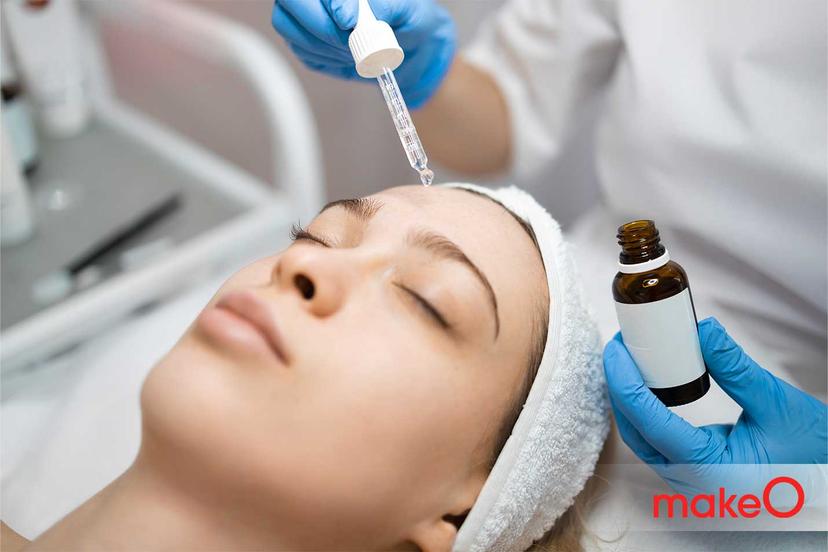MakeO blog
Acne is a widespread skin condition affecting numerous individuals globally which occurs when hair follicles become blocked with oil and dead skin cells, leading to the development of pimples, blackheads, and whiteheads. While acne can negatively impact self-esteem, numerous treatment options are available to combat this issue and get healthier skin. Skin treatments for acne consist of a range of approaches, including topical products, oral medications, and specialized procedures. Among these procedures, chemical peel treatment has gained considerable popularity as an effective solution for combating acne.
Chemical Peels for Acne
Chemical peels are cosmetic procedures that involve applying a chemical solution to the skin, leading to exfoliation and subsequent peeling. An acne peel treatment stimulates the growth of new, healthier skin cells, resulting in a smoother, clearer appearance. A chemical peel for acne is proven to be an effective treatment, aiding in the reduction of breakouts, minimizing acne scars, and improving overall skin texture.
1. Superficial Peels
Superficial peels are the mildest form and typically employ alpha hydroxy acids (AHAs) like glycolic acid or lactic acid. This skin treatment for acne primarily targets the outermost skin layer, effectively exfoliating dead skin cells and unclogging pores. Achieving desired results with superficial peels may require multiple sessions.
2. Medium-Depth Peels
Medium-depth peels penetrate deeper into the skin layers and often utilize trichloroacetic acid (TCA). They are suitable for addressing more severe acne concerns and can stimulate collagen production to improve acne scarring. Recovery time for medium-depth peels is generally longer compared to superficial peels.
3. Deep Chemical Peels
In cases of severe acne or deep scarring, deep chemical peels may be recommended. These peels employ phenol, a potent chemical solution that penetrates deeply into the skin layers. While deep peels provide more dramatic results, they necessitate significant downtime and meticulous aftercare due to their intense nature.
Commonly Used Ingredients in Chemical Peels
Chemical peels are available in various types, ranging from superficial to deep peels, depending on acne severity and desired outcomes. Chemical peels for acne incorporate various active ingredients that contribute to their efficacy. Here are some frequently used ingredients:
1. Glycolic Acid
Derived from sugar cane, glycolic acid is an alpha hydroxy acid renowned for its exfoliating properties. It aids in removing dead skin cells, unclogging pores, and improving skin texture.
2. Salicylic Acid
This beta hydroxy acid is highly effective in treating acne. It penetrates the pores, reduces inflammation, and eliminates excess oil. Salicylic acid also facilitates gentle exfoliation through a chemical peel for acne scars.
3. Lactic Acid
Another alpha hydroxy acid, lactic acid is derived from milk. It assists in exfoliating the skin, promoting cell turnover, and enhancing the absorption of other acne-fighting ingredients.
4. TCA (Trichloroacetic Acid)
TCA is commonly used in medium-depth chemical peels for acne. It helps reduce acne breakouts, even out skin tone, and minimize acne scars.
5. Mandelic Acid
As an AHA, mandelic acid boasts both exfoliating and antibacterial properties. It successfully unclogs pores, reduces inflammation, and tackles hyperpigmentation caused by acne.
Chemical Peels for Acne at Home with makeO skinnsi
With makeO skinnsi, you will find a variety of products to combat your acne situation. You can shop for products such as a serum, perfecting toner, facewash, and sheet mask from makeO skinnsi to effectively combat acne and acne scars. These products are specifically designed while keeping the requirements of acne-prone skin in mind. You can also opt for services such as makeO skinnsi peel and makeO skinnsi scar reduction from the comfort of your home.
An acne chemical peel offers a promising solution for individuals grappling with acne. By promoting skin exfoliation and renewal, chemical peels effectively address acne breakouts, reduce acne scars, and enhance overall skin texture. Whether opting for a superficial, medium-depth, or deep chemical peel, it is crucial to consult with a dermatologist or skin care professional to determine the best chemical peel for acne scar based on individual needs and skin condition. It is important to bear in mind that chemical peels may involve some downtime and require careful aftercare to ensure optimal results and minimize potential side effects.
FAQs
Are chemical peels good for acne?
Chemical peels can be beneficial for acne by unclogging pores, reducing oil production, and improving acne scars, but it is important to consult with a dermatologist to find the most suitable chemical peel for scars for individual skin concerns.
Which chemical peel is best for pimples?
Salicylic acid peels are often recommended for pimples due to their ability to penetrate the skin, unclog pores, and combat acne-causing bacteria, resulting in a clearer complexion with fewer breakouts.
Does peeling remove acne permanently?
While chemical peels can significantly improve acne and reduce its appearance, they do not offer a permanent solution, and consistent skincare and maintenance treatments may be necessary for long-term acne management.
How many sessions of chemical peels for acne?
The number of sessions required for acne chemical peels can vary depending on the severity of the acne and the specific peel used. Typically, multiple sessions spaced several weeks apart may be recommended to achieve optimal results, and a dermatologist will determine the appropriate treatment plan based on individual needs.
related categories
Related articles

Anti-Ageing Face Oils: Unveiling the 10 Best Facial Oils for Youthful Skin

5 Common Mistakes to Avoid When Using a Face Roller

Is Aloe vera effective for acne? Find out

5 Side Effects of Hair Removal Creams That You Must Know

